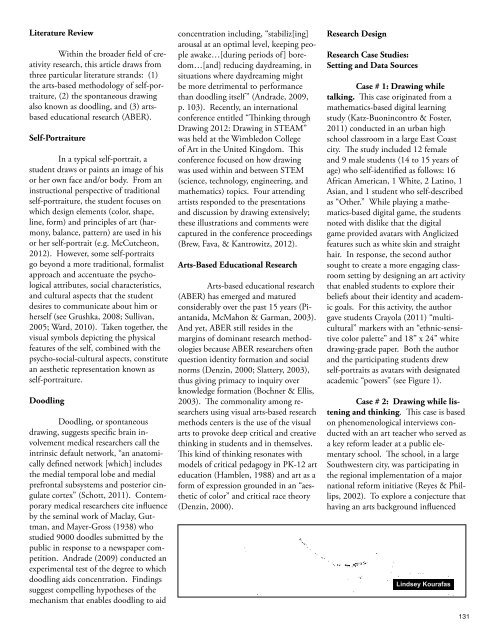Torrance Journal for Applied Creativity
TorranceJournal_V1
TorranceJournal_V1
You also want an ePaper? Increase the reach of your titles
YUMPU automatically turns print PDFs into web optimized ePapers that Google loves.
Literature Review<br />
Within the broader field of creativity<br />
research, this article draws from<br />
three particular literature strands: (1)<br />
the arts-based methodology of self-portraiture,<br />
(2) the spontaneous drawing<br />
also known as doodling, and (3) artsbased<br />
educational research (ABER).<br />
Self-Portraiture<br />
In a typical self-portrait, a<br />
student draws or paints an image of his<br />
or her own face and/or body. From an<br />
instructional perspective of traditional<br />
self-portraiture, the student focuses on<br />
which design elements (color, shape,<br />
line, <strong>for</strong>m) and principles of art (harmony,<br />
balance, pattern) are used in his<br />
or her self-portrait (e.g. McCutcheon,<br />
2012). However, some self-portraits<br />
go beyond a more traditional, <strong>for</strong>malist<br />
approach and accentuate the psychological<br />
attributes, social characteristics,<br />
and cultural aspects that the student<br />
desires to communicate about him or<br />
herself (see Grushka, 2008; Sullivan,<br />
2005; Ward, 2010). Taken together, the<br />
visual symbols depicting the physical<br />
features of the self, combined with the<br />
psycho-social-cultural aspects, constitute<br />
an aesthetic representation known as<br />
self-portraiture.<br />
Doodling<br />
Doodling, or spontaneous<br />
drawing, suggests specific brain involvement<br />
medical researchers call the<br />
intrinsic default network, “an anatomically<br />
defined network [which] includes<br />
the medial temporal lobe and medial<br />
prefrontal subsystems and posterior cingulate<br />
cortex” (Schott, 2011). Contemporary<br />
medical researchers cite influence<br />
by the seminal work of Maclay, Guttman,<br />
and Mayer-Gross (1938) who<br />
studied 9000 doodles submitted by the<br />
public in response to a newspaper competition.<br />
Andrade (2009) conducted an<br />
experimental test of the degree to which<br />
doodling aids concentration. Findings<br />
suggest compelling hypotheses of the<br />
mechanism that enables doodling to aid<br />
concentration including, “stabiliz[ing]<br />
arousal at an optimal level, keeping people<br />
awake…[during periods of] boredom…[and]<br />
reducing daydreaming, in<br />
situations where daydreaming might<br />
be more detrimental to per<strong>for</strong>mance<br />
than doodling itself” (Andrade, 2009,<br />
p. 103). Recently, an international<br />
conference entitled “Thinking through<br />
Drawing 2012: Drawing in STEAM”<br />
was held at the Wimbledon College<br />
of Art in the United Kingdom. This<br />
conference focused on how drawing<br />
was used within and between STEM<br />
(science, technology, engineering, and<br />
mathematics) topics. Four attending<br />
artists responded to the presentations<br />
and discussion by drawing extensively;<br />
these illustrations and comments were<br />
captured in the conference proceedings<br />
(Brew, Fava, & Kantrowitz, 2012).<br />
Arts-Based Educational Research<br />
Arts-based educational research<br />
(ABER) has emerged and matured<br />
considerably over the past 15 years (Piantanida,<br />
McMahon & Garman, 2003).<br />
And yet, ABER still resides in the<br />
margins of dominant research methodologies<br />
because ABER researchers often<br />
question identity <strong>for</strong>mation and social<br />
norms (Denzin, 2000; Slattery, 2003),<br />
thus giving primacy to inquiry over<br />
knowledge <strong>for</strong>mation (Bochner & Ellis,<br />
2003). The commonality among researchers<br />
using visual arts-based research<br />
methods centers is the use of the visual<br />
arts to provoke deep critical and creative<br />
thinking in students and in themselves.<br />
This kind of thinking resonates with<br />
models of critical pedagogy in PK-12 art<br />
education (Hamblen, 1988) and art as a<br />
<strong>for</strong>m of expression grounded in an “aesthetic<br />
of color” and critical race theory<br />
(Denzin, 2000).<br />
Research Design<br />
Research Case Studies:<br />
Setting and Data Sources<br />
Case # 1: Drawing while<br />
talking. This case originated from a<br />
mathematics-based digital learning<br />
study (Katz-Buonincontro & Foster,<br />
2011) conducted in an urban high<br />
school classroom in a large East Coast<br />
city. The study included 12 female<br />
and 9 male students (14 to 15 years of<br />
age) who self-identified as follows: 16<br />
African American, 1 White, 2 Latino, 1<br />
Asian, and 1 student who self-described<br />
as “Other.” While playing a mathematics-based<br />
digital game, the students<br />
noted with dislike that the digital<br />
game provided avatars with Anglicized<br />
features such as white skin and straight<br />
hair. In response, the second author<br />
sought to create a more engaging classroom<br />
setting by designing an art activity<br />
that enabled students to explore their<br />
beliefs about their identity and academic<br />
goals. For this activity, the author<br />
gave students Crayola (2011) “multicultural”<br />
markers with an “ethnic-sensitive<br />
color palette” and 18” x 24” white<br />
drawing-grade paper. Both the author<br />
and the participating students drew<br />
self-portraits as avatars with designated<br />
academic “powers” (see Figure 1).<br />
Case # 2: Drawing while listening<br />
and thinking. This case is based<br />
on phenomenological interviews conducted<br />
with an art teacher who served as<br />
a key re<strong>for</strong>m leader at a public elementary<br />
school. The school, in a large<br />
Southwestern city, was participating in<br />
the regional implementation of a major<br />
national re<strong>for</strong>m initiative (Reyes & Phillips,<br />
2002). To explore a conjecture that<br />
having an arts background influenced<br />
Lindsey Kourafas<br />
131


